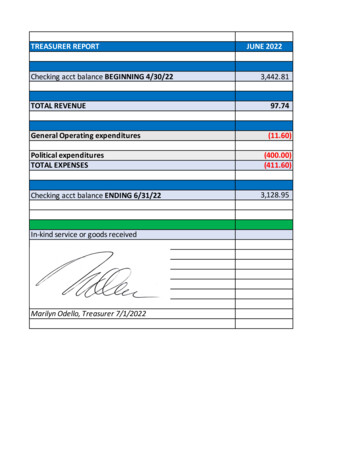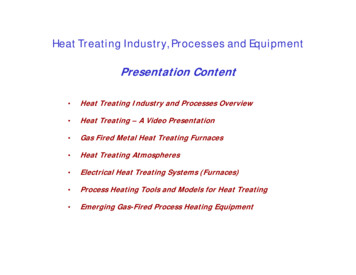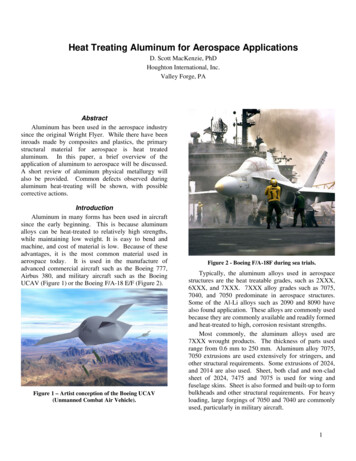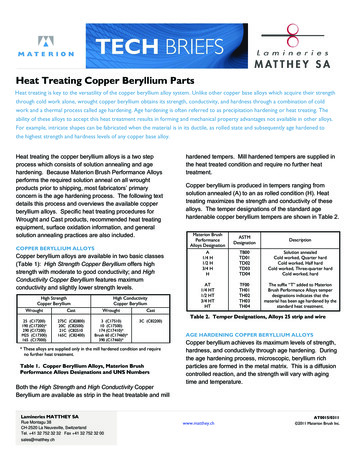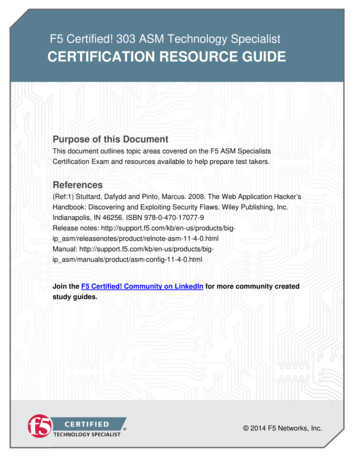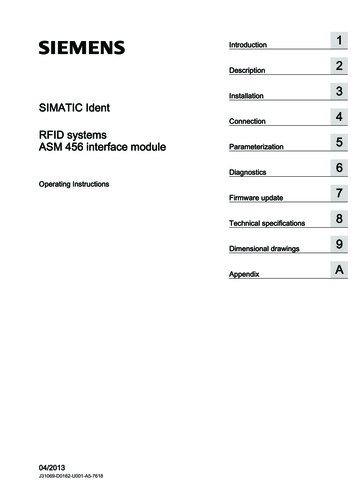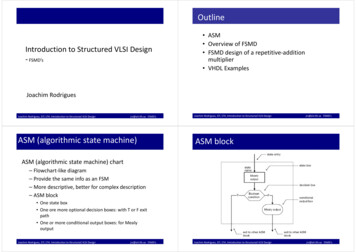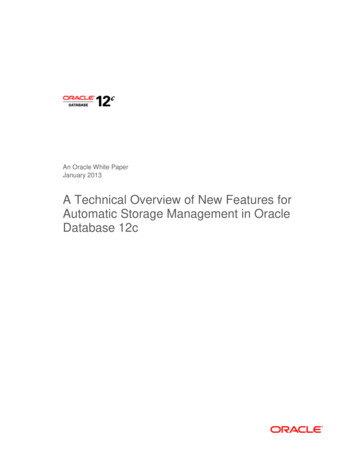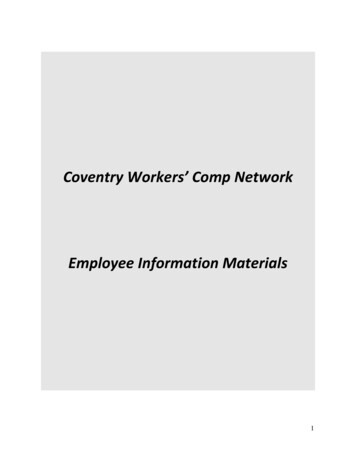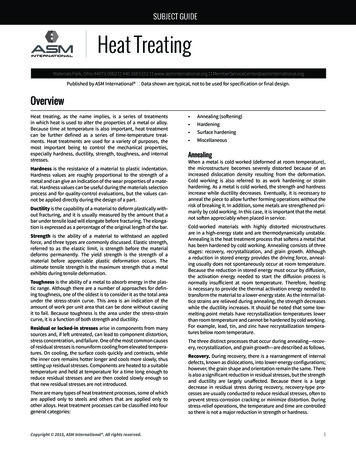
Transcription
SUBJECT GUIDESubjectGuideHeat Treating:: 440.338.5151 :: www.asminternational.org :: MemberServiceCenter@asminternational.orgPublished by ASM International :: Data shown are typical, not to be used for specification or final design.Materials Park, Ohio 44073-0002OverviewHeat treating, as the name implies, is a series of treatmentsin which heat is used to alter the properties of a metal or alloy.Because time at temperature is also important, heat treatmentcan be further defined as a series of time-temperature treatments. Heat treatments are used for a variety of purposes, themost important being to control the mechanical properties,especially hardness, ductility, strength, toughness, and internalstresses.Hardness is the resistance of a material to plastic indentation.Hardness values are roughly proportional to the strength of ametal and can give an indication of the wear properties of a material. Hardness values can be useful during the materials selectionprocess and for quality-control evaluations, but the values cannot be applied directly during the design of a part.Ductility is the capability of a material to deform plastically without fracturing, and it is usually measured by the amount that abar under tensile load will elongate before fracturing. The elongation is expressed as a percentage of the original length of the bar.Strength is the ability of a material to withstand an appliedforce, and three types are commonly discussed. Elastic strength,referred to as the elastic limit, is strength before the materialdeforms permanently. The yield strength is the strength of amaterial before appreciable plastic deformation occurs. Theultimate tensile strength is the maximum strength that a metalexhibits during tensile deformation.Toughness is the ability of a metal to absorb energy in the plastic range. Although there are a number of approaches for defining toughness, one of the oldest is to consider it as the total areaunder the stress-strain curve. This area is an indication of theamount of work per unit area that can be done without causingit to fail. Because toughness is the area under the stress-straincurve, it is a function of both strength and ductility.Residual or locked-in stresses arise in components from manysources and, if left untreated, can lead to component distortion,stress concentration, and failure. One of the most common causesof residual stresses is nonuniform cooling from elevated temperatures. On cooling, the surface cools quickly and contracts, whilethe inner core remains hotter longer and cools more slowly, thussetting up residual stresses. Components are heated to a suitabletemperature and held at temperature for a time long enough toreduce residual stresses and are then cooled slowly enough sothat new residual stresses are not introduced.There are many types of heat treatment processes, some of whichare applied only to steels and others that are applied only toother alloys. Heat treatment processes can be classified into fourgeneral categories:Copyright 2015, ASM International . All rights reserved. Annealing (softening) Hardening Surface hardening MiscellaneousAnnealingWhen a metal is cold worked (deformed at room temperature),the microstructure becomes severely distorted because of anincreased dislocation density resulting from the deformation.Cold working is also referred to as work hardening or strainhardening. As a metal is cold worked, the strength and hardnessincrease while ductility decreases. Eventually, it is necessary toanneal the piece to allow further forming operations without therisk of breaking it. In addition, some metals are strengthened primarily by cold working. In this case, it is important that the metalnot soften appreciably when placed in service.Cold-worked materials with highly distorted microstructuresare in a high-energy state and are thermodynamically unstable.Annealing is the heat treatment process that softens a metal thathas been hardened by cold working. Annealing consists of threestages: recovery, recrystallization, and grain growth. Althougha reduction in stored energy provides the driving force, annealing usually does not spontaneously occur at room temperature.Because the reduction in stored energy must occur by diffusion,the activation energy needed to start the diffusion process isnormally insufficient at room temperature. Therefore, heatingis necessary to provide the thermal activation energy needed totransform the material to a lower-energy state. As the internal lattice strains are relieved during annealing, the strength decreaseswhile the ductility increases. It should be noted that some lowmelting-point metals have recrystallization temperatures lowerthan room temperature and cannot be hardened by cold working.For example, lead, tin, and zinc have recrystallization temperatures below room temperature.The three distinct processes that occur during annealing—recovery, recrystallization, and grain growth—are described as follows.Recovery. During recovery, there is a rearrangement of internaldefects, known as dislocations, into lower-energy configurations;however, the grain shape and orientation remain the same. Thereis also a significant reduction in residual stresses, but the strengthand ductility are largely unaffected. Because there is a largedecrease in residual stress during recovery, recovery-type processes are usually conducted to reduce residual stresses, often toprevent stress-corrosion cracking or minimize distortion. Duringstress-relief operations, the temperature and time are controlledso there is not a major reduction in strength or hardness.1
SUBJECT GUIDESubjectGuideHeat Treating:: 440.338.5151 :: www.asminternational.org :: MemberServiceCenter@asminternational.orgPublished by ASM International :: Data shown are typical, not to be used for specification or final design.Materials Park, Ohio 44073-0002Recrystallization is characterized by the nucleation and growthof strain-free grains out of the matrix of the cold-worked metal.During recrystallization, the badly deformed cold-worked grainsare replaced by new, strain-free grains. New orientations, newgrain sizes, and new grain morphologies form during recrystallization. The driving force for recrystallization is the remaining stored energy that was not expended during recovery. Thestrength reduces and the ductility increases to levels similar tothose of the metal before cold working.Recrystallization is considered complete when the mechanicalproperties of the recrystallized metal approach those of the metalbefore it was cold worked. Recrystallization and the resultingmechanical softening completely cancel the effects of cold working on the mechanical properties of the piece. An annealing curvefor an alloy, such as a typical brass, will show minimal changesin mechanical properties during recovery and large changes inproperties that occur during recrystallization (Fig. 1). Mechanicalproperties, such as hardness, yield strength, tensile strength, percent elongation, and reduction in area, change drastically over avery small temperature range. Although physical properties, suchas electrical conductivity, undergo large increases during recovery, they also continue to increase during recrystallization.Grain growth is the growth of some recrystallized grains, andit can only happen at the expense of other recrystallized grains.Because fine grain size leads to the best combination of strengthand ductility, in almost all cases, grain growth is an undesirableprocess. Although excessive grain growth can occur by holdingthe material for too long at the annealing temperature, it is usually a result of heating at too high a temperature.Some steel-specific annealing heat treatments include normalizing, spheroidizing, and solution annealing, which is describedas follows.Fig. 1 Effects of annealing on brass (Cu-35%Zn). Source: Ref 1Copyright 2015, ASM International . All rights reserved.Solution annealing, sometimes referred to as quench annealing, is an important category of annealing. The heat treatmentis called solution annealing because the heat treatment takesadvantage of the solid-solution regions of the iron-carbon phasediagram (for steels) or, in the case of nonferrous alloys, the phasediagrams for the major components of the alloy system (see thetopic summary “Phase Diagrams”).For steels, solution annealing involves heating to a sufficientlyhigh temperature for a sufficiently long time to drive free carbidesinto solid solution and then rapidly quenching to freeze them.The resulting steel has improved formability, and corrosion resistance to certain acids can be improved.For nonferrous alloys, solution annealing is a preliminary stepto hardening of the alloys. The solution heat treatment involvesheating the alloy to a high enough temperature to drive the alloying elements into solid solution, yielding a metastable, supersaturated solid solution. These alloys are then precipitation hardened(also known as age hardening).HardeningHardening is the process by which heat treatments are employedto harden an alloy. Hardenability is the capability of an alloy tobe hardened by heat treatment. There are several hardeningtreatments.Quench Hardening. For ferrous alloys, quench hardening is anaustenite-forming (austenitizing) heat treatment, followed bycooling at a rate such that a substantial amount of austenitetransforms to martensite. Quench hardening can be applied tosuitable alpha-beta alloys (usually copper or titanium alloys) bysolution treating them, followed by quenching to develop a martensite-like structure.Tempering of steel is a process in which previously hardenedor normalized steel is heated to a temperature below the lowercritical temperature and cooled at a suitable rate, primarily toincrease ductility and toughness but also to increase the grainsize of the matrix. Tempering is used to reach specific valuesof mechanical properties, to relieve quenching stresses, and toensure dimensional stability. It usually follows quenching fromabove the upper critical temperature; however, tempering is alsoused to relieve the stresses and reduce the hardness developedduring welding and to relieve stresses induced by forming andmachining. In the context of aluminum alloys, temper designations are used to codify combinations of heat treatments. Theseare described in Table 1 in the section “Heat Treatment of Aluminum-Base Alloys.”Precipitation hardening (age hardening) involves heatingan alloy to a sufficiently high temperature so that enough of analloying element is dissolved to form a supersaturated solid solution. It is then rapidly cooled (quenched) to room temperature,freezing the alloying elements in solution (Fig. 2). On reheating to2
SUBJECT GUIDESubjectGuideHeat Treating:: 440.338.5151 :: www.asminternational.org :: MemberServiceCenter@asminternational.orgPublished by ASM International :: Data shown are typical, not to be used for specification or final design.Materials Park, Ohio 44073-0002Variants of quenching and tempering as they relate to specificsteel heat treatments include marquenching, austempering, andausforming.Surface HardeningSurface hardening is used to impart desirable properties in thesurface of the component that are not needed (or achievable)through the part.Flame hardening consists of austenitizing the surface of a steelby heating with an oxyacetylene or oxyhydrogen torch andquenching immediately. A hard surface layer of martensite formsover a softer interior core.Induction Hardening. Electromagnetic induction is used to heatthe surface layer of a ferrous workpiece to above the critical temperature and is followed immediately by quenching.Case hardening is any of several processes applicable to steelthat change the chemical composition of the surface layer byabsorption of carbon, nitrogen, or a mixture of the two and, bydiffusion, create a concentration gradient on the surface. The processes commonly used are carburizing and quench hardening,cyaniding, nitriding, and carbonitriding.There are other surface diffusion treatments, such as boronizing and siliconizing, that diffuse elements other than carbon andnitrogen into the workpiece surface for the purpose of alteringthe surface properties.Miscellaneous Heat TreatmentsFig. 2 Precipitation-hardenable phase diagram and heat treatment.Source: Ref 1There are numerous heat treatments designed for specific materials, forms (e.g., wire), or property outcomes. Examples includepatenting, stiffening tempering, and malleablizing, among others.Heat Treatment of SteelAlloy systems that lend themselves to precipitation hardeninginclude aluminum alloys, some copper alloys, iron- and nickelbase superalloys, maraging steels, and precipitation-hardeningstainless steels.Because over 80% by weight of all metals in use are iron and steelalloys, the heat treatment of ferrous alloys is of great industrialimportance. One of the primary advantages of steels is their capability to attain high strengths through heat treatment while stillretaining some degree of ductility. This capability of steels to bestrengthened is a direct consequence of the amount of carbonpresent. As the carbon content is increased, higher strength levelsare obtainable. Although the ductility decreases with increasingstrength, it is still high enough to satisfy most engineering applications. Heat treatments can be used not only to harden steelsbut also to provide other useful combinations of properties, suchas ductility, formability, and machinability.Oxide Dispersion Strengthening. With this powder metallurgymethod, oxides such as yttria or alumina or metals that are strongoxide formers, such as tantalum, are added during the mechanical alloying step. They become uniformly distributed through thealloy and impart strength to the component.The important heat treatment processes for ferrous alloys includeannealing, stress relieving, normalizing, spheroidizing, hardeningby quenching and tempering, and case hardening. In all of theseprocesses, the steel is heated fairly slowly to some predeterminedtemperature and then cooled. It is the temperature and the rate ofan intermediate temperature, the host metal rejects the alloyingelement in the form of a fine, uniformly distributed precipitate inthe alloy matrix. Thefigse fine precipitate particles act as barriers to the motion of dislocations and provide resistance to slip,thereby increasing the strength and hardness. There are somealloys, such as copper-beryllium alloys, that will age harden atroom temperature.Copyright 2015, ASM International . All rights reserved.3
SUBJECT GUIDESubjectGuideHeat Treating:: 440.338.5151 :: www.asminternational.org :: MemberServiceCenter@asminternational.orgPublished by ASM International :: Data shown are typical, not to be used for specification or final design.Materials Park, Ohio 44073-0002cooling that determines the resultant structure of the steel.The final structure is independent of the rate of heating, provided it has been slow enough for the steel to reach structural equilibrium at its maximum temperature. However, thesubsequent rate of cooling, which determines the nature ofthe final structure, is critical and may vary between slow furnace cooling to sudden cooling by quenching in water.Annealing. In steels, annealing usually means a heat treatment with furnace cooling from the austenitizing range(Fig. 3). Annealing is used to reduce hardness, obtain a relatively near-stable microstructure, refine grain size, improvemachinability, and facilitate cold working. For hypoeutectoid steels (steels with a carbon content of less than 0.80%),full annealing consists of heating to 90 to 180 C (50 to100 F) above the A3 temperature, and for hypereutectoidsteels (steels with a carbon content of more than 0.80%), heating above the A1 temperature, followed by very slow cooling.Process annealing consists of heating steel to a tempera ture justbelow the A1 eutectoid temperature for a short time. This providesstress relief, makes the steel easier to form, and is applied to lowcarbon cold-rolled sheet steels to restore ductility. The temperatures used range from 550 to 650 C (1020 to 1200 F). Slow coolingis not essential for process annealing, because any cooling ratefrom tem peratures below A1 will not affect the microstructure orhardness. Although recrystallization can occur due to the storedenergy from cold working, there are no phase changes, and theferrite and cementite constituents remain the same throughoutthe process.Normalizing. Steel is normalized by heating 160 to 200 C (90to 110 F) into the austenite-phase field at temperatures somewhat higher than those used by annealing, followed by coolingat a medium rate. For carbon steels and low-alloy steels, normalizing means air cooling. Many steels are normalized to establisha uniform microstructure and grain size. The faster cooling rateduring normalizing results in a much finer microstructure, whichis harder and stronger than the coarser microstructure producedby full annealing. Steel is normalized to refine grain size, make itsstructure more uniform, make it more responsive to hardening,and to improve machinability. When steel is heated to a high temperature, the carbon can readily diffuse, resulting in a reasonablyuniform composition from one area to the next. The steel is thenmore homogeneous and will respond to the heat treatment moreuniformly. The properties of normalized steels depend on theirchemical composition and the cooling rate, with the cooling ratebeing a function of the size of the part. Although there can be aconsiderable variation in the hardness and strengths of normalized steels, the structure usually contains a fine microstructure.Spheroidizing. To produce a steel in its softest possible condition with minimum hardness and maximum ductility, it can bespheroidized by heating just above or just below the A1 eutectoid temperature and then holding at that temperature for anCopyright 2015, ASM International . All rights reserved.Fig. 3 Steel heat treating ranges. Source: Ref 1extended period of time. Spheroidizing can also be conducted bycyclic processing, in which the temperature of the steel is cycledabove and below the A1 line. This process breaks down lamellarstructure into small pieces that form small spheroids through diffusion in a continuous matrix. Surface tension causes the carbideparticles to develop a spherical shape. Because a fine initial carbide size accelerates speroidization, the steel is often normalizedprior to spheroidizing.Hardening. To harden a steel by quenching, it must be heated toa sufficiently high temperature to produce an austenitic crystalline phase and then quenched (quickly cooled). On quenching,the austenite phase transforms to martensite, which is a hardand strong but brittle crystalline phase. The quenched hardnessdepends on the chemical composition and the cooling rate during quenching.Steels with higher carbon contents produce higher hardness, andthe addition of alloying elements allows martensitic structures todevelop through thicker sections. The carbon content is criticalto the ability to harden steel. Because ductility decreases withincreasing carbon content, the carbon content is held to approximately 0.45% in many engineering steels. However, when wearresistance is required, for example, in tool and die steels, it may beincreased to over 1.0%. The addition of alloying elements allowsthicker sections to be hardened or allows less drastic quenches.The effect of alloying elements and section size on hardenability can be illustrated by comparing the plain carbon steel 1040with the alloy steel 4140 (Fig. 4). In this example, both the 1040and 4140 steels contain nominal carbon contents of 0.40%, andyet, due to the alloying elements in 4140, the 4140 hardens to amuch greater depth. However, as the diameter of a bar of 4140is increased from 5 to 10 cm (2 to 4 in.), the depth of hardening4
SUBJECT GUIDESubjectGuideHeat Treating:: 440.338.5151 :: www.asminternational.org :: MemberServiceCenter@asminternational.orgPublished by ASM International :: Data shown are typical, not to be used for specification or final design.Materials Park, Ohio 44073-0002ing process is called martempering. In martempering, the part isquenched into a molten salt bath at a temperature just above thetemperature at which martensite starts to form. When the partreaches thermal equilibrium, it is removed from the salt bath andallowed to air cool and form martensite. The objective is to delaythe cooling just above the martensitic transformation for longenough to equalize the temperature throughout the piece and minimize distortion, cracking, and residual stresses. It should be notedthat even though this process is called martempering, it is not atempering process; instead, it is a hardening process. Thus, martempered steels must be tempered before being placed in service.Fig. 4 Effect of alloying and section size on hardenability. Source:Ref 1decreases. Some more highly alloyed steels are so deep hardening that they will form fully martensitic structures in fairly thicksections by air cooling to room temperature.Cooling rates are controlled by the quenchant used, with brine,water, oil, and forced air producing progressively slower quenching speeds. While plain carbon steels such as 1040 must bequenched in brine or water to develop 100% martensite in eventhin sections, alloy steels such as 4140 can be oil quenched toproduce fully martensitic structures in thicker sections. When asteel is quenched to room temperature, the outside cools muchfaster than the interior, setting up contraction stresses in thesteel. Then, when the austenite transforms to martensite, there isa volume expansion that causes large residual tensile stresses onthe surface. The combined effect of these contraction and expansion stresses can cause distortion and even cracking. The milderoil quench minimizes residual quenching stresses that causedistortion and cracking problems. Some tool steels are so highlyalloyed that they can be air quenched and still produce fully martensitic structures in thick sections.The martensite produced by quenching is extremely strong andhard but is too brittle to be used in most applications. It mustbe tempered by reheating to an intermediate temperature. Thetemperature selected depends on the application. For example, atempering temperature of 150 C (300 F) will impart some toughness with a minimal loss in strength, while a higher temperingtemperature (e.g., 700 C, or 1300 F) will produce much greaterductility and toughness but at a significant loss in strength.Another strategy to reduce quenching stresses is to use an interrupted quench. The most frequent type of interrupted quenchCopyright 2015, ASM International . All rights reserved.Austempering is another interrupted quenching process in whichthe objective is to form a bainitic structure. Bainite can be considered to be a structure that is intermediate between ferrite andmartensite. Like martempering, the part is quenched into a saltbath above the temperature at which martensite starts to form.However, it is allowed to remain at that temperature until thetransformation to bainite is complete. Austempering offers several potential advantages, including increased ductility, toughness, and strength at a given hardness, reduced distortion, andthe ability to heat treat steels to a hardness of 35 to 55 HRC without having to temper. One of the outstanding attributes of austempered steels is their high impact resistance.Case Hardening. There are some applications where it is necessary to have a hard, wear-resistant surface but a tough, shockresistant inner core. Examples include camshafts, gears, and rodsthat require hard surfaces to resist wear but tough inner cores toresist shock. While a low-carbon steel containing 0.1% C will havea tough core, its surface hardness will be low after hardening. Onthe other hand, a high-carbon steel containing 0.8% C will havea high surface hardness after hardening, but the core will not betough and shock resistant. There are two main approaches to thisproblem. One is to use a medium-carbon steel and only harden thesurface through heat treatment such as flame or induction hardening. The other approach is to diffuse carbon or nitrogen into the surface layers of a low-carbon steel in processes such as carburizing,nitriding, cyaniding, carbonitriding, and ferritic nitrocarburizing.When a carburized steel is heat treated, the high-carbon surfacelayers will attain a much higher hardness than the low-carbon core.Heat Treatment of Aluminum-Base AlloysFor an aluminum alloy to be precipitation hardened (i.e., aged),the alloy must contain a sufficient amount of at least one elementor compound that has an appreciable solubility at high temperatures and minimal solubility at lower temperatures. Elementsthat have this characteristic are copper, zinc, silicon, and magnesium. Additionally, the element or compound must be capableof forming an intermetallic precipitate in the aluminum matrix.Alloys that are not aged sufficiently to obtain maximum hardnessare said to be underaged, while those that are aged past peakhardness are said to be overaged. Underaging can be a result ofartificially aging at an insufficiently high temperature or for an5
SUBJECT GUIDESubjectGuideHeat Treating:: 440.338.5151 :: www.asminternational.org :: MemberServiceCenter@asminternational.orgPublished by ASM International :: Data shown are typical, not to be used for specification or final design.Materials Park, Ohio 44073-0002aging time that is too short, while overaging is usually a result ofaging at too high a temperature.supersaturated solution to form a very fine precipitate in thealuminum matrixAluminum alloys classified as heat treatable are the 2xxx, 6xxx,7xxx, and some of the 8xxx wrought alloys. Precipitation hardening is conducted in three steps:The solution heat treating temperature is as high above the solidsolubility curve as possible without melting the lowest-meltingpoint eutectic constituents. Therefore, close temperature control,normally 5 C ( 10 F), is required for the furnaces used to heattreat aluminum alloys. If the temperature is too high, incipientgrain-boundary melting occurs; the part is ruined and must bescrapped. On the other hand, if the temperature is too low, dissolution will be incomplete, and the aged alloy will not developas much strength as expected. The solution heat treating timeshould be long enough to allow diffusion to establish an equilibrium solid solution. Table 1 summarizes the temper designationsfor combinations of heat treatments for aluminum alloys.1.Heating to the solution heat treating temperature and soaking long enough to put the elements or compounds intosolution2.Quenching to room or some intermediate temperature (e.g.,water) to keep the alloying elements or compounds in solution; essentially creating a supersaturated solid solution3.Aging at either room temperature (natural aging) or a moderately elevated temperature (artificial aging) to cause theTable 1Temper designations for aluminum alloysSuffix letter “F,” “O,” “H,”“T,” or “W,” indicates basictreatment conditionFirst suffix digit indicatessecondary treatment usedto influence propertiesSecond suffix digit forcondition H only indicatesresidual ucts onlyH—Cold worked, strainhardened1—Cold worked only2— Cold worked and partiallyannealed3—Cold worked and stabilizedW—Solution heat treated2—1/4 hard4—1/2 hard6—3/4 hard8—Hard9—Extra hardT—Heat treated, stableT1—Cooled from an elevated-temperature shaping operation natural agedT2—Cooled from an elevated-temperature shaping operation cold worked natural agedT3—Solution treated cold worked natural agedT4—Solution treated natural agedT5—Cooled from an elevated-temperature shaping operation artifical agedT6—Solution treated artificial agedT7—Solution treated overagedT8—Solution treated cold worked artificial agedT9—Solution treated artificial aged cold workedT10—Cooled from an elevated-temperature shaping operation cold worked artificial agedSource: Ref 1Copyright 2015, ASM International . All rights reserved.6
SUBJECT GUIDESubjectGuideHeat Treating:: 440.338.5151 :: www.asminternational.org :: MemberServiceCenter@asminternational.orgPublished by ASM International :: Data shown are typical, not to be used for specification or final design.Materials Park, Ohio 44073-0002The product form can determine the time required for solutionheat treatment. For example, castings require more time thanwrought products to dissolve their relatively large constituentsinto solution. The time required can vary anywhere from less thana minute for thin sheet up to 20 h for large sand castings.After the elements are dissolved into solution, the alloy isquenched to a relatively low temperature to keep the elements insolution. Quenching is perhaps the most critical step in the heattreating operation. The challenge is to quench the part fast enoughto keep the hardening elements in solution while, at the sametime, minimizing residual quenching stresses that cause warpageand distortion. In general, the highest strength levels and the bestcombinations of strength and toughness are obtained by using thefastest quench rate possible. Resistance to corrosion and stresscorrosion cracking (SCC) is usually improved by faster quenchingrates; however, the resistance to SCC of certain copper-free 7xxxalloys is actually improved by slow quenching. While fast quenching rates can be achieved by cold water, slower quenching rates(e.g., hot or boiling water) are often used to sacrifice some strengthand corrosion resistance for reduced warpage and distortion.If premature precipitation during quenching is to be avoided, tworequirements must be met. First, the time required to trans
Heat Treating Overview Heat treating, as the name implies, is a series of treatments in which heat is used to alter the properties of a metal or alloy. Because time at temperature is also important, heat treatment can be further defined as a series of time-temperature treat-ments. Heat treatments are used for a variety of purposes, the
